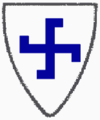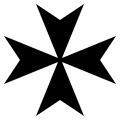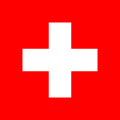Cross
From Wikipedia, the free encyclopedia

A cross is a geometrical figure consisting of two lines or bars perpendicular to each other, dividing one or two of the lines in half. The lines usually run vertically and horizontally; if they run diagonally, the design is technically termed a saltire.
The cross is one of the most ancient human symbols, and is used by many religions, such as Christianity. It is frequently a representation of the division of the world into four elements (Chevalier, 1997) (or cardinal points), or alternately as the union of the concepts of divinity, the vertical line, and the world, the horizontal line (Koch, 1955).
Contents |
[edit] Etymology
The word cross was introduced to English in the 10th century as the term for the instrument of the torturous execution of Christ (gradually replacing the earlier word rood), ultimately from Latin crux, via Old Irish cros. The word can nowadays refer to the geometrical shape unrelated to its Christian significance. The Latin Crux (translating Greek stauros) was a Roman torture device used for crucifixion.
[edit] History
It is not known when the first cross image was made; after circles, crosses are one of the first symbols drawn by children of all cultures. There are many cross-shaped incisions in European cult caves, dating back to the earliest stages of human cultural development in the stone age. Like other symbols from this period, their use continued in the Celtic and Germanic cultures in Europe. For example, celtic coins minted many centuries before the Christian era may have an entire side showing this type of cross, sometimes with the five cardinal points marked by concave depressions in the same style as in stone age carvings. Other coins may be showing the cross held by a rider on a horse and springing forth a fern leaf, sometimes identified as a Tree of Life symbol. there is also a cross named the cossifictition.It is rare and is only found in 1 continent of Europe. This is the most sacred Cross
[edit] As markings
Written crosses are used for many different purposes, particularly in mathematics.
- The Roman numeral for ten is X.
- In the Latin alphabet, the letter X and the minuscule form of t are crosses.
- The Chinese character for ten is 十; (see Chinese numerals).
- The dagger or obelus (†)
- The addition (or plus) sign (+) and the multiplication (or times) sign (×).
A cross is often used as a check mark because it can be clearer, easier to create with an ordinary pen or pencil, and less obscuring of the text or image that is already present than a large dot. It also allows marking a position more accurately than a large dot.
A large cross through a text often means that it is wrong or should be considered deleted.
[edit] As emblems and symbols
| Cross Name | Description | Picture |
|---|---|---|
| Christian cross |
Also known as the Latin cross or crux ordinaria. It is the most common symbol of Christianity, intended to represent the death of Jesus when he was crucified on the True Cross and his resurrection in the New Testament. |
 |
| Ankh |
Also known as the Key of the Nile, the Looped Tau Cross, and the Ansate Cross. It was an Ancient Egyptian symbol of life and fertility. Sometimes given a Latin name if it appears in specifically Christian contexts, such as the crux ansata ("handled cross"). |
 |
| Coptic ankh |
The Coptic ankh is the Ankh related pre Original Coptic cross of the early Gnostic Christians in Egypt. |
 |
| Original Coptic Cross |
The original Coptic cross used by early Gnostic Christians in Egypt. |
 |
| Sun cross |
Also known as the Sunwheel, solar cross or Odin's cross, because Odin's symbol in Norse mythology was a cross in a circle. Used throughout Native American culture to represent the great Medicine Wheel of life. It's also the symbol used by the Gnostic Movements. |
 |
| High cross |
Free-standing Celtic crosses commonly found in Ireland and to a lesser extent in Great Britain, very common in churches and graveyards. |
 |
| Coptic Cross |
A small circle from which emanate four arms of equal length, with angled T shapes in the corners, cross-pieces outward, representing the nails used in Jesus' crucifixion. This cross receives its name from Coptic Christianity, which centered around Alexandria, Egypt. |
 |
| Canterbury cross |
Used in the Anglican Churches. It has four arms of equal length, each widening at the outer end in a hammer shape so that their rims nearly form a circle. Each arm bears a triangular panel incised with a triquetra symbolizing the Trinity. In the center of the cross is a small square. The Anglo-Saxon original, as a brooch, dates from c. 850 A.D. and was excavated in 1867 in Canterbury, England. A stone replica can be found in Canterbury Cathedral and in many other Anglican cathedrals around the world. [1] |
 |
| Crucifix |
A cross with a representation of Jesus' body hanging from it. It is primarily used in the Catholic Church, Anglican churches, and Eastern Orthodox churches, and it emphasizes Christ's sacrifice— his death by crucifixion. |
 |
| Greek cross |
Used especially by Eastern Orthodoxy and Early Christianity Also known as the crux immissa quadrata. Has all arms of equal length. Often the arms curve wider as they go out. |
 |
| Florian cross |
Adopted as an emblem by the fire service, this cross is named for Saint Florian, the patron saint of Poland, Austria and firefighters. Although similar to the Maltese Cross and Cross pattée, it differs in having arms rounded outwards at the ends. Two different versions are included here; the one above is commonly found on fire service badges, patches, and emblems; the one below is typical of the St. Florian medallion or medal. |
  |
| Eastern cross |
Used in the Eastern Orthodox Church and Eastern Catholic Churches of Byzantine rite. The top line is said to represent the headboard, and the bottom, slanted line represents the footrest, wrenched loose by Jesus' writhing in intense agony. It is raised to the left side, because that was the side of the righteous criminal who said to Jesus: "remember me when you come into your kingdom". This symbolises the victory of good over evil. The letters IC XC found at the end of the main arm of most Eastern Orthodox Crosses are a Christogram, representing the name of Jesus Christ. |
 |
| St. Brigid's Cross |
This cross is found throughout Ireland. It is told that the cross was made by Brigid, daughter of a pagan king from reeds to be used as an instrument of conversion. However, Brigid's name is derived from Brigit (also spelled Brigid, Brìghde, Brìde, and Bríde), a Celtic Goddess of fire, poetry, and smithcraft, and today the cross is used to protect houses from fire. This is an example of the integration of religious traditions. |
 |
| Labarum |
Constantine I's Labarum is also known as a Chrismon, Chi-Rho (from the two Greek letters that make it up) or monogram of the first two letters of the name Christ. Several other forms of Chrismons exist. |
 |
| Lorraine Cross |
Used in heraldry. It is similar to a patriarchal cross, but usually has one bar near the bottom and one near the top, rather than having both near the top. Is part of the heraldic arms of Lorraine in eastern France. It was originally held to be a symbol of Joan of Arc, renowned for her perseverance against foreign invaders of France. |
 |
| Marian Cross |
Included on the coat of arms of Pope John Paul II, the Marian Cross is a Catholic adaptation of the traditional Latin cross to emphasize Catholic devotion to Mary. |
 |
| Nordic Cross |  |
|
| Occitan cross |
Based on the counts of Toulouse's traditional coat of arms, it soon became the symbol of Occitania as a whole. |
 |
| Papal Cross |
The three cross-bars represent the Pope's triple role as Bishop of Rome, Patriarch of the West, and successor of St. Peter, Chief of the Apostles. |
 |
| Patriarchal cross |
Similar to a traditional Christian cross, but with an additional, smaller crossbar above the main one meant to represent all the Orthodox Christian Archbishops and Patriarchs. In the Eastern Orthodox Church, this cross is sometimes seen with an additional, slanted bar near the foot of the cross (see Byzantine Cross). This cross is similar to the Lorraine Cross and the Caravaca Cross. |
 |
| Presbyterian Cross | Used by Presbyterian denominations. |  |
| Red Cross |
Used as a symbol for medical care in most of the world, the Red Crescent being used in Islamic countries and the Magen David Adom in Israel. |
 |
| Cross of Sacrifice |
A Latin cross with a superimposed sword, blade down. It is a symbol used by the Commonwealth War Graves Commission at the site of many war memorials. |
 |
| Royal Flag of Georgia |
Used in Georgia as national flag, first used by Georgian King Vakhtang Gorgasali in the 5th century and later adopted by Queen Tamar of Georgia in the 13th century. The flag depicts a Jerusalem cross, adopted during the reign of George V of Georgia who drove out the Mongols from Georgia in 1334. |
 |
| St. Nino's Cross |
Also known as a "Grapevine cross" and traditionally ascribed to Saint Nino, the 4th-century female baptizer of the Georgians, it is used as a symbol of the Georgian Orthodox Church. |
 |
| St. Thomas Cross |
Also known as a "Mar Thoma Cross" and traditionally ascribed to Saint Thomas,the Apostole of India, it is used as a symbol of the Syro Malabar Catholic Church and venerated by all Saint Thomas Christians denominations. |
 |
| Saint Andrew's Cross |
Used in Scotland's national flag and the naval ensign of the Russian Navy, it is also called the Saltire, the Boundary Cross (because it was used by the Romans as a barrier) and the crux decussata. Saint Andrew is believed to have suffered a martyr's death on such a cross, hence its name. The cross does not have to be at this particular angle to qualify as a saltire; the symbol X can also be considered a St. Andrew's Cross. |
 |
| St George's Cross |
Used in England's national flag. |
 |
| Saint Peter's Cross/Inverted Cross |
An upside-down Latin cross, based on a tradition that holds that Saint Peter was martyred by being crucified upside-down. Today it is often associated with anti-Christian or Satanic groups. |
 |
| Skull and crossbones |
Not a cross as such, but a saltire made of bones, with an overlaid skull. While traditionally associated with pirates, it was actually relatively rarely used by them, each ship having its own design, often involving an hourglass. |
 |
| Tau Cross |
Also known as Saint Anthony's Cross, the Egyptian Cross and the crux commissa. It is shaped like the letter T. Francis of Assisi used it as his signature. |
 |
| Thieves' Cross |
Also known as the Furka Cross. The fork, shaped like the letter Y. [2] |
 |
| Mariner's Cross |
The Mariner's Cross is a stylized cross in the shape of an anchor. The Mariner's Cross is also referred to as St. Clement's Cross in reference to the way he was martyred. |
 |
| Order of Christ Cross |
Cross originally used by the Portuguese Order of Christ. Since then it has become a symbol of Portugal, used on the sails of the carracks during the Discoveries Era, and currently by the Madeira Autonomous Region of Portugal and the Portuguese Air Force. |
 |
| Extreme-right variant of the Celtic Cross |
Some white nationalist and neo-fascist groups adopted this variation of the Celtic cross, made up of simple lines, without any of the ornamental complexity of traditional Celtic crosses. It is thought that this basic variation's minor resemblance to the swastika[citation needed] is the reason it has become popular in such circles. |
 |
[edit] In heraldry
These crosses are ones used primarily or exclusively in heraldry and do not necessarily have any special meanings commonly associated with them. Not all the crosses of heraldry and the crosses with commonly known contexts are listed below.
| Cross name | Description | Picture |
|---|---|---|
| The cross as heraldic "ordinary" |
A simple heraldic cross (the default if there are no additional specifying words) has arms of roughly equal length, artistically proportioned to the particular shape of the shield, which extend to the edges of the shield. Illustrated is the blazon "Azure, a cross Or" (i.e. a gold cross on a blue shield). A cross which does not extend to the edges of the shield is humetty, in heraldic terminology. |
 |
| Cross anchry |
A stylized cross in the shape of an anchor. Also known as the anchored cross or mariner's cross. |
 |
| Cross barbée |
Also known as the cross barby or arrow cross, this symbol consists of two double-ended arrows in a cross configuration. Best known today for its use by the fascist Arrow Cross Party in the 1930s, the symbol actually dates to ancient times and was used by Hungarian tribes in the Middle Ages.[citation needed] In Christian use, the ends of this cross resemble the barbs of fish hooks, or fish spears. This alludes to the Ichthys symbol of Christ, and is suggestive of the "fishers of men" theme in the Gospel. |
 |
| Cross bottony |
A cross with the ends of the arms bottony (or botonny), i.e. shaped like an architectural trefoil. It occurs counterchanged on the flag of Maryland. |
 |
| Cross cercelée |
A cross which, opening at the ends, turns round both ways, like a ram's horns. |
 |
| Cross crosslet |
A cross with the ends of each arm crossed. |
 |
| Cross fleury |
A cross with the ends of the arms fleury (or flory), having a shape like a fleur-de-lys. |
 |
| Cross fourchee |
One form of the heraldic cross fourchee (fourchée, fourchy) or cross fourche (meaning "forked"). |
 |
| Cross fylfot |
Upright cross with truncated bent arms |
 |
| Jerusalem cross |
Also known as the Crusader's Cross. This cross was the symbol of the Crusader Kingdom of Jerusalem, which existed for almost two hundred years after the First Crusade. The four smaller crosses are said to symbolize either the four books of the Gospel or the four directions in which the Word of Christ spread from Jerusalem. Alternately, all five crosses can symbolize the five wounds of Christ during the Passion. This symbol is also used in the flag of Georgia. It is also the logo for the Knights and Dames of the Holy Sepulcher of Jerusalem as well as the Franciscan order's Custody of the Holy Land. Many retreats including the Ignatian Kairos Retreat, and the Marian L.I.F.E. retreat bestow this cross on its participants as a sign of shared spirituality. |
 |
| Maltese cross |
With arms which narrow towards the center, and are indented at the ends. The "eight-pointed cross" (with no curved lines). |
 |
| Cross moline |
In a cross moline, the ends of the arms are split and curved back. |
 |
| Cross patonce |
A cross patonce is more or less intermediate between a cross pattée and a cross flory (or fleury). |
 |
| Cross pattée |
A cross pattee (pattée, patty), or formée (formy) has arms narrowing towards the centre, but with non-indented ends. See also Iron Cross. |
 |
| Cross pommee |
A cross pommee (pommée, pommy) has a circular knob at the end of each arm. |
 |
| Cross potent |
This cross has a crossbar at the end of each of its arms. "Potent" is an old word for a crutch, and is used in heraldic terminology to describe a T shape. It is used by many, mostly Roman Catholic, Scouting and Guiding organisations in their logos and insignia. |
 |
| Quadrate |
A cross with a square at the intersection point. |
 |
| Cross triple parted and fretted |
In heraldry, a "cross triple parted and fretted" (or "treble parted and fretted") is interlaced. Here, a version which is "Or on an Azure field" (gold on blue) is shown. |
 |
| Cross voided |
A "cross voided throughout", also known as the Gammadia, can be seen as a Greek cross with its centre lines removed, or as composed of four angles (L shapes) separated by a thin space. So the name "gammadia" refers to its being made up of four shapes similar to a capital Greek letter gamma; the word gammadion can also refer to a swastika. |
 |
| Cross fitchy | A cross fitchy is a variation where the lower part is fashioned as a sword blade. This can be combined with other variations, e.g. cross crosslet fitchy. |  |
| Cross of St James |
The Cross of St. James, similar to a Cross Flory Fitch, is formed by a Cross Flory, where the lower part is fashioned as a sword blade (fitched)—making this a cross of a warrior. It is most frequently depicted in red. (The version depicted here is the one used by the order of Santiago.) |
 |
There are numerous other variations on the cross in heraldry. See heraldry for background information.
The semi-classic book A Glossary of Terms Used in Heraldry by James Parker (1894) is online, and contains much information about variants of crosses used in heraldry.
[edit] In flags
Several flags have crosses, including all the nations of Scandinavia, whose crosses are known as Scandinavian crosses, and many nations in the Southern Hemisphere, which incorporate the Southern Cross. The Flag of Switzerland since the 17th century has displayed an equilateral cross in a square (the only square flag of a sovereign state apart from the Flag of the Vatican City); the Red Cross emblem was based on the Swiss flag.
|
|
|
|
|
|
|
|
|
|
|
|
|
|
|
|
|
|
|
|
|
|
|
|
|
|
|
|
|
|
|
[edit] Other noteworthy crosses
The Crux, or Southern Cross, is a cross-shaped constellation in the Southern Hemisphere. It appears on the national flags of Australia, Brazil, New Zealand, Niue, Papua New Guinea and Samoa.
The tallest cross, at 152.4 metres high, is part of Francisco Franco's monumental "Valley of the Fallen", the Monumento Nacional de Santa Cruz del Valle de los Caidos in Spain.
The tallest cross in the United States, at 198 feet (60.3 m) tall, is allegedly located in Effingham, Illinois, at the junction of Interstates 57 and 70.
The 5th-century BC tombs at Naqsh-e Rustam, Iran, are carved into the cliffside in the shape of a cross. They are known as the "Persian crosses".
[edit] See also
- Cross in Christian Art
- Christian cross
- Christianity
- Cross and Crown
- Crossbuck
- Cross burning
- Crucifixion
[edit] References
- Chevalier, Jean (1997). "The Penguin Dictionary of Symbols". Penguin ISBN 0140512543
- Koch, Rudolf (1955). The Book of Signs. Dover, NY. ISBN 0-486-20162-7.
- Drury, Nevill (1985). Dictionary of Mysticism and the Occult. Harper & Row ISBN 0060620935
- Webber, F. R. (1927, rev 1938). Church Symbolism: an explanation of the more important symbols of the Old and New Testament, the primitive, the mediaeval and the modern church. Cleveland, OH. OCLC 236708.
[edit] External links
- seiyaku.com: All Crosses
- Variations of Crosses - Images and Meanings
| Wikimedia Commons has media related to: crosses |
























